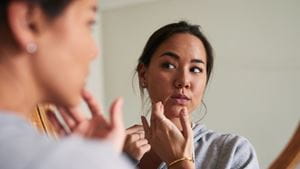
Facial hair removal is not something that should be seen as embarrassing. Millions of girls and women are living with unwanted hair and seek out methods of removing it.
Beth Lertzman, MD, is a dermatologist with Rochester Regional Health and discusses what happens when you tweeze your facial hair, side effects, and alternative techniques of hair removal.
Human hair has four different cycles of growth: growing, transitioning, resting, and shedding.
When you pluck or tweeze a hair, it often happens during the hair’s growing (anagen) phase. Pulling out that hair excites the thin layer of tissue called epithelium that makes up the outer layer of your skin (epidermis).
This process can cause some inflammation in the hair follicle, which is why people see redness and swelling after tweezing hairs.
Sometimes, people will tweeze facial hair once or twice to get rid of unwelcome hairs in certain areas. However, prolonged tweezing or tweezing multiple hairs can lead to unwanted side effects.
Some side effects include:
If you begin to see redness or swelling, stop and allow your skin time to heal. See a provider if you are experiencing prolonged redness or pain after a procedure. Using moisturizer on the area where your hair was removed can help.
“Plucking or tweezing is not the preferred method of hair removal as recommended by dermatologists,” Dr. Lertzman said. “There are other techniques – both at-home and in a dermatologist’s office – that are safe and effective when it comes to removing unwanted hair from the face.”
For hairs that are close to or directly on skin with moles or acne, more tweezing can lead to more inflammation. If the goal of tweezing or plucking facial hair is to make your face cleaner, tweezing can cause the opposite effect.
In some cases, as the skin near the hair follicles become more inflamed, this can cause moles and acne to flare up – and potentially lead to ingrown hairs.
Repeatedly irritating areas of the skin with ingrown hairs can lead to further inflammation and potential infection.
“If you are going to tweeze facial hair, be sure that both your skin and the utensils you are using are clean,” Dr. Lertzman said. “Avoid tweezing any areas of the face that may have an infection; this can make the infection worse.”
While tweezing is a quick, short-term solution for hair removal, Dr. Lertzman recommends other methods of hair removal – both at home and at Rochester Regional Health dermatology locations such as the WNY Genesee Valley Dermatology & Laser Centre.
This is a basic at-home method that many people use. Trimming down your hair using a razor or other devices is common.
There is an old wives’ tale about avoid shaving your face because the hairs will grow back more quickly. According to Dr. Lertzman, tweezing or shaving certain areas of your face does not change how quickly the hairs grow back or how long the hairs remain on the face.
While the devices or materials being used are different, this technique of hair removal is essentially the same as tweezing. Hairs are being pulled out of the skin using an epilator or hot wax with a cloth strip.
Some hair removal creams such as Vaniqa will thin hair follicles or slow their growth. FDA approval guidelines for Vaniqa suggest using the product in addition to shaving hair.
This procedure permanently reduces hair of the body using laser devices. The procedure carries some risks such as redness or temporary pigmentation. However, infection is not a risk.
Lasers can be used on skin that have acne and/or moles; skin cannot be infected if a laser is being used. Our dermatologists and technicians have a variety of lasers to available for different populations based on thicknesses of hair, color of hair, and skin color.
“This method of hair removal is very safe,” Dr. Lertzman said. “Since the effects are last for a long time, it may be worth weighing laser hair removal against repeated hair tweezing and the future risk of inflammation or infection.”
By using a thin wire (thinner than a hair!) into a hair follicle and running an electric current to the wire, the root of the hair becomes damaged – causing the hair to fall out. Depending on how much hair you want to remove, multiple sessions may be necessary.
If laser hair removal is not something you want to experience, electrolysis can be a good, safe alternative.
“There are a variety of safe in-office alternatives that are affordable and effective,” Dr. Lertzman said. “Schedule a consultation with a dermatologist to have a conversation about what the best method of hair removal might be for you.”